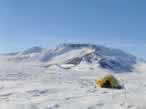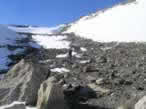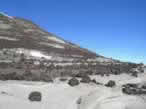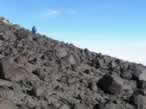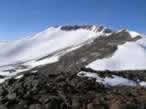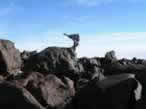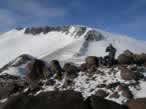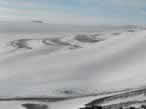An Extraordinary Day Atop Mercer Ridge
Yesterday was an extraordinary
day – so extraordinary, in fact,
that I was too tired to write about it last night! Now, with a fresh
mind, I will try to qualify the journey with the majesty that we all
experienced.
With time being of the essence (since new logistical developments have resulted
in a pull-out that could be in two minutes or two weeks), we were praying for
a nice day to climb Mercer Ridge and sample the high elevation ice-cored moraines
deposited by the alpine glacier flowing down the southwest face of Mercer Ridge.
It was a beautiful day we needed to make the ascent up the ridge, and it was a beautiful day we got! There was hardly a whisper of wind, and the dark dolerites gave off heat waves slightly distorting the horizon. We arrived by snowmobile to the base of the sandstone terraces we had explored the day before, and followed a gulley of ice and rock onto the higher of the terraces, providing access to the ridge. We had packed for a long day’s climb, including crampons and axe, and elected not to bring the trusty (but rather cumbersome, when attached to an already full pack) Trimble differential GPS receiver.
Having worked our way up the gulley, we noticed another vast garden of perched dolerite cobbles that have been sculpted into all sorts of bizarre, twisted shapes by around 10 million years of being blasted by wind. The beautiful Martian gnome garden, with the added shelter from the wind and warmth of the sun, made me want to build a home nestled into this exotic little niche.
Ascending further onto the ridge, we had to climb an ever-steepening set of rotten sandstone terraces that eventually became a loose, steep scree. This required some careful footwork, but did not pose any significant difficulties. We soon reached the dolerite outcrop capping the top of the ridge, which had the strange rounded cobbles actively eroding out to be dropped down the slope. I believe this strange, old cobbles were therefore not glacially transported along the sandstone terraces, but have merely been stranded – sitting on the terraces for ages while the sandstone edges eventually drew out from underneath, and dropped the dolerite gnomes just a little further downslope.
Climbing over the top of the dolerite cliffs, we were treated with a gorgeous plateau of strange rock formations, sculpted for millions of years by the blasting wind. The day was not windy however, and we enjoyed the warm, dark rocks absorbing the solar radiation. The top of this small, intermediate part of Mercer Ridge led gently down to a little hollow of snow and ice, which led to an easy crossing (no need to use the crampons, but an ice-axe was a handy crevasse prod to ease my nervousness). We sidled along the eastern side of the ridge from here, across a vast dolerite boulder talus slope. It appeared that this talus slope bulged out towards the base of the mountain in a series of gelifluction lobes – a rock glacier. One could dig the ice axe in between any of the boulders, and below the angle of repose, only ice could be found – with no bedrock detectable.
Crossing the scree ahead of the others, I realized the next obstacle was a bit of a steep ice-filled gorge that coalesced with the lower crevassed portion of the glacier we sought. This did not appeal to me, and the moraines we were after appeared much higher than we thought. So I scrambled directly up the talus to the top of the ridgeline, where I was treated to a spectacular view of the two alpine glaciers flowing off opposite sides of the ridge, separated by a thin knife-edge of stratified sandstones, and topped with intense dolerite cliffs. Far below on the western side, I could see the whole set of moraines that we had sampled before, as well as step-like sequence of sandstones on Terrace Ridge to the north. I tried to use the timer on my camera to get a shot of me in front of the glaciers, but am afraid to see the result.
I hung around up top for a while, and realized that the best route to the moraines was to head along the ridgeline a short way before crossing a snowfield over to the glacier. Pete joined me at the top, and reaffirmed my belief that this was the best way to go. Robert, on the other hand, sidled along the scree, and found a route connecting to the snowfield around the base of the knoll on which we stood.
We met for lunch on the moraine we were to sample, and marveled at the amazing weather as we sipped soup from our thermoses. I reckoned that the ravine separating the knoll we had just climbed was a fault weakening the bedrock en echelon with the gorge between Discovery Ridge and Treves Butte. It appeared as the stratigraphic sequence of sandstones and coal horizons, capped by the dolerite, had all been up-thrust between Mercer Ridge and Mount Schopf.
The magnificent glacier on which we ate lunch, was formed by an impressive snow-slope of the south-south-west face of Mercer Ridge. The slope quickly flattened out into blue ice that flowed SSW only for a bit, and then took a 90 degree turn to flow down the southeast side of the ridge in a series of dramatic, crevassed ice falls. The moraines on which we sat were located directly on the outer turn of the glacier, and represent times when the glacier had more accumulation was able to flow further on its initial SSW trajectory. The snowslope revealed some excellent clues regarding the morainal deposits, as large boulders from a recent rockfall could be seen being actively incorporated into the flowing ice.
After lunch we got to work sampling a transect across the profile of the ice-cored moraine series. A series of ridges, growing lower and lower towards the active ice surface, appeared to represent previous stable ice margins, where material was concentrated at the edge enough to protect the ice underneath from sublimation. The troughs in between the ridges, may represent transitional periods when the ice was shrinking back from the turn. The erratics comprising each ridge appeared distinctly less-weathered as I drew closer to the active ice surface. In addition to collecting samples from each ridge, I made sure to collect one that was been exposed from the current ice elevation. This should have an exposure age of zero, and any age it gives will represent the inherited He (dolerite) and Be (Sandstone) component, thus allowing us to calibrate the sequence.
Needless to say, we are all extremely pleased with having sampled a well-preserved glacial sequence one such a fine day. As Pete said once we were down off the ridge: “This one was ‘out of the box’!” I certainly sense the foundations for a thesis from these samples today…
We returned to camp late, around 2100h, where I cooked pork chops, veggies, and baked beans. A simple, quick meal that let us a retire to our respective tents with a full stomach to help us reflect on such a wonderful day.
Today was significantly less exciting than yesterday, as we awoke in a thick haze. The big news of the morning was that we might actually be pulled out either today or tomorrow, weather depending. Of course it ended up not being today.
By the afternoon, the weather cleared, and I went for a ‘moon jog’ in my cold-weather gear, included the giant bunny boots. It certainly felt like running on the moon, but still with the gravity of earth – making it a bit of a challenge. I headed along the ski-doo trail toward the crevasses, where I halted, and turned around. I then returned and spent the rest of the afternoon concocting a seafood pasta with alfredo sauce. I sautéed and shucked shrimp, scallops, and canned baby clams in a butter sauce with basil, onions, garlic, and parsley. I then let them simmer in the alfredo sauce while the pasta was boiling and the beans were steaming. A somewhat healthier meal than the copious amounts of red meat we seem to be drawn towards for every meal… My guilt forced me towards this meal, but I think it was a welcome change of diet for the three of us.
After dinner we had our second ‘toast to the last night in the field,’ and went to bed shortly thereafter. I am guessing we will toast to the same thing in the cook tent tomorrow evening as well, but I am not complaining about being out here. Perhaps another day of sampling, and perhaps rock collecting for gifts and museum donations is in order before I am ready to leave our home here.

